Shibazuke is a popular pickle that originated in Kyoto. These salty and slightly sour pickles have a beautiful natural purple color from purple shiso leaves. Enjoy these pickles with steamed rice or ochazuke.
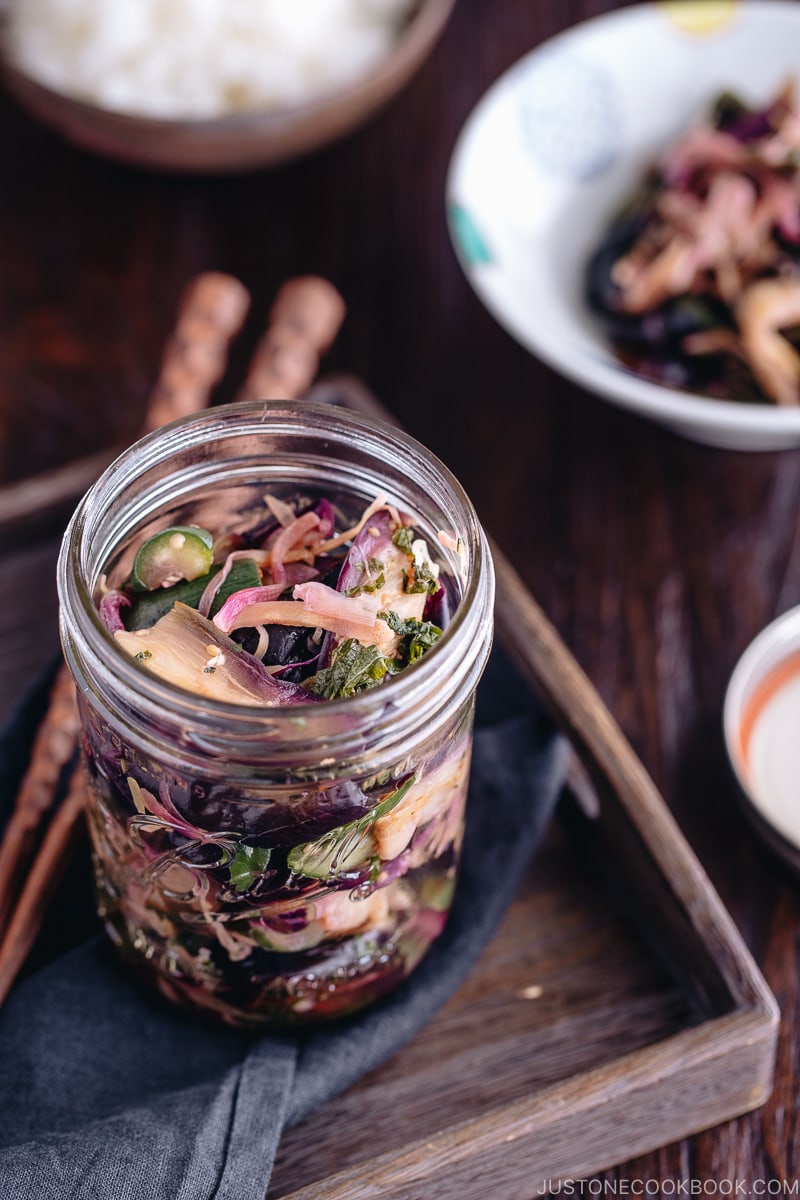
Shibazuke (柴漬け) is probably my favorite type of Japanese pickles. Until I tried making it from scratch, I wasn’t exactly sure what was in the pickle. Imagine my surprise when I found out it includes vegetables that I love – eggplant, shiso leaves, and myoga to name a few. The beautiful hues of purple and rosy pink of the vegetable medley truly capture the taste of nature, making this pickle extra special. If you have a thing for pickles, it’s hard not to fall in love with shibazuke.
Now before any pickle fans get too excited, I want to give you a heads-up. The ingredients for this recipe may not be easy to find even in your local Japanese grocery stores. I had trouble getting them as well.
However, let me introduce this delicious pickle to you anyway since you might have a chance to taste it when you visit Japan.
Table of Contents
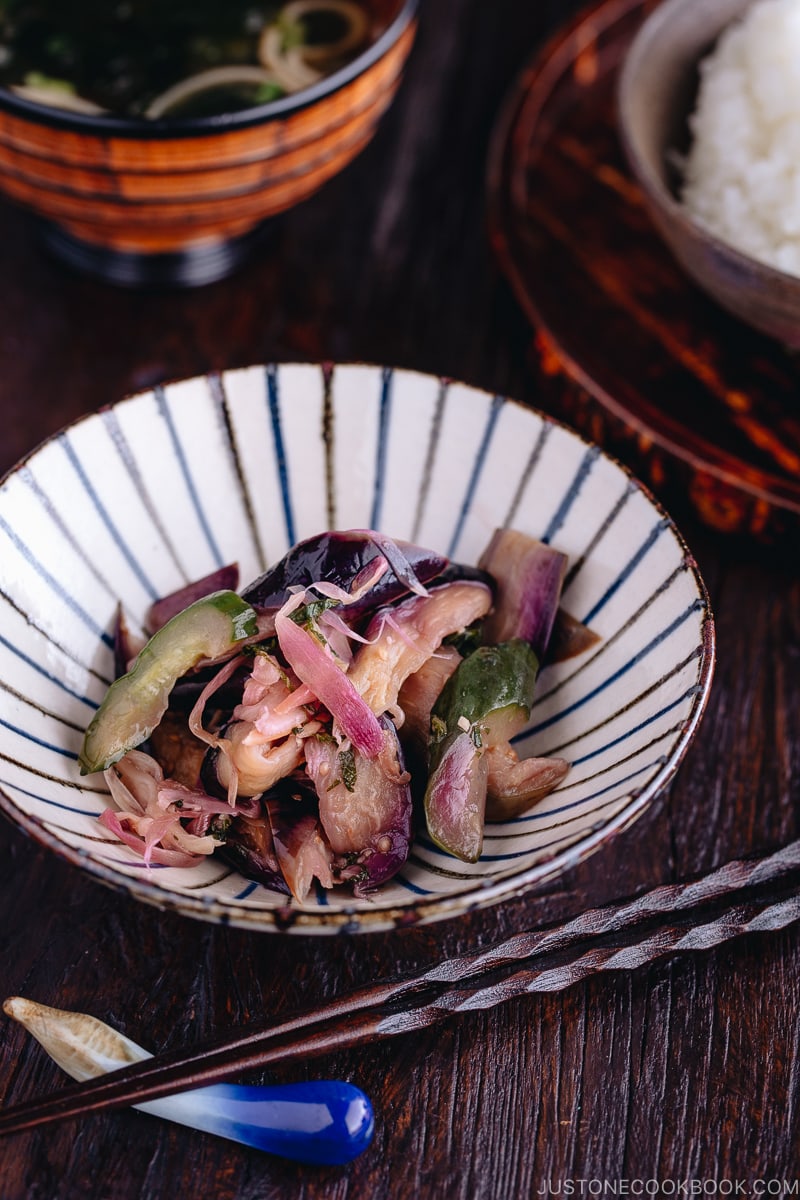
What is Shibazuke?
Shibazuke (柴漬け, originally 紫葉漬け) is one of the three main Kyoto pickles (京漬物) besides radish pickle Suguki (すぐき) and thinly-slice radish pickle Senmaizuke (千枚漬け).
This bright purple pickle is made of cucumber, eggplant, purple shiso (aka-jiso), ginger, and myoga, which are pickled in umezu (Japanese plum vinegar). The salty, slightly sour taste of shibazuke comes from salt pickling and lactic acid fermentation.
Although shibazuke is commonly served in Kyoto cuisine, they are enjoyed throughout Japan. This Fujikko’s “Shibazuke Tabetai!” TV commercial in 1985 made shibazuke really popular in Japan. Does anyone remember this TV commercial? I do!
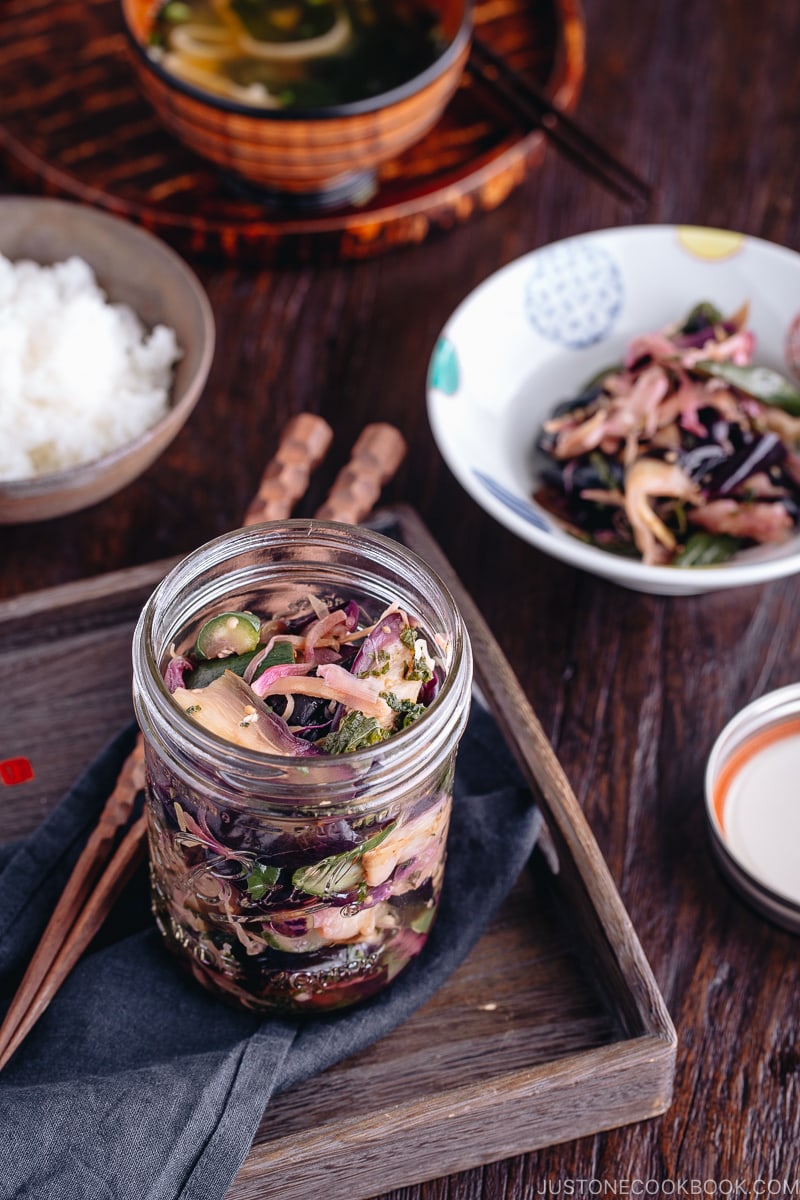
3 Unique Japanese Ingredients for Shibazuke
1. Aka Shiso (purple perilla leaves)
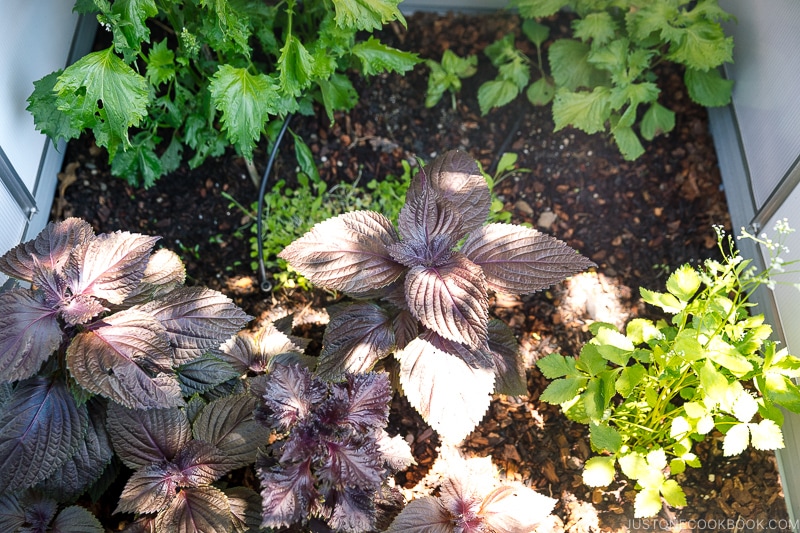
Ohara (大原), a suburb of Kyoto, has a good climate for growing shiso leaves. As Ohara is a basin, there is a drastic temperature difference between day and night, which results in high-quality fragrant shiso leaves. Therefore, Shibazuke made in Ohara uses a generous amount of purple shiso leaves (aka-jiso 赤紫蘇) without adding color additives.
When I was looking for ingredients to make shibazuke back in May in SF Bay Area, I couldn’t find purple shiso. Therefore, I had to use green shiso (ao-jiso 青紫蘇) instead. These two shiso leaves are slightly different in flavor but they make the closest substitute.
Purple red shiso is used for natural coloring to make umeboshi (Japanese pickled plum) and shibazuke, but not for eating as a herb. Green shiso leaves are commonly used for garnish, salad, toppings, and cooking as a herb.
If you have access to purple shiso, please see my Notes section in the recipe.
2. Myoga (Japanese ginger)
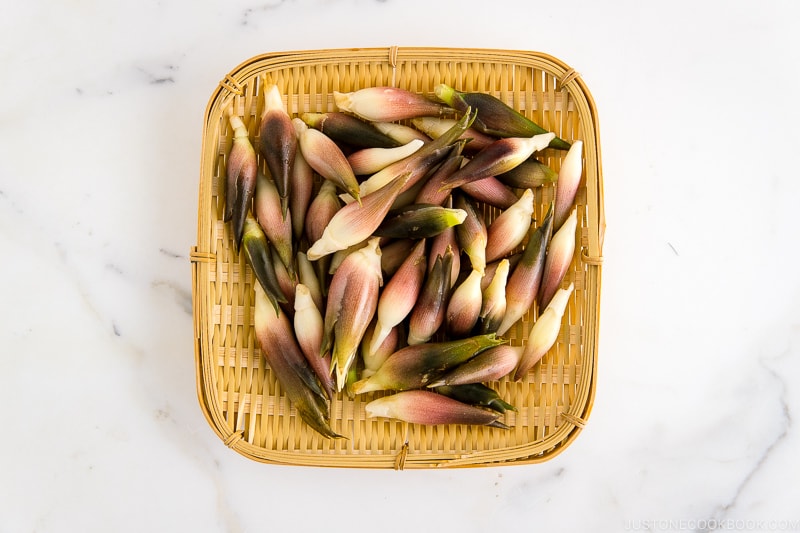
With a unique flavor and texture, this ginger bud is a wonderful aromatic. Myoga’s season is summer and it is served as a spice (yakumi 薬味) for cold somen noodles and Hiyayakko (chilled tofu).
I was lucky to find myoga before the summer comes, but one pack of 3 myoga costed me $8! I’m currently in Japan writing this post, and today I saw the exact same package of myoga which came from the same place for only 99 yen (about 90 cents)…
3. Umezu (Ume plum vinegar)
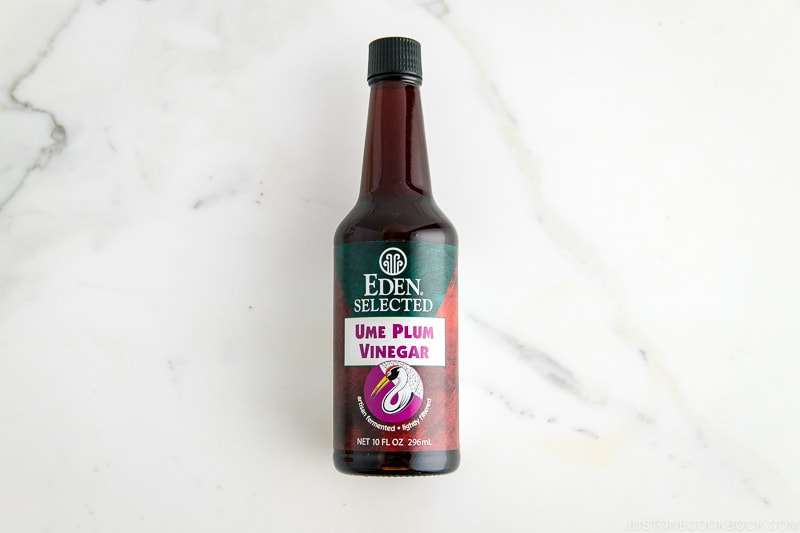
Umezu or Ume Plum Vinegar (赤梅酢) is the pickling brine from making umeboshi plums (Japanese pickled plums) with sea salt and purple shiso, that imparts its ruby red color. It’s a tart, salty, festive condiment with beneficial organic acids.
Since I didn’t have the purple shiso, I used umezu to make pickles and to add the purple color. This Eden brand has no artificial dyes, preservatives, or chemicals. You can find the umezu in Japanese grocery stores or on Amazon.
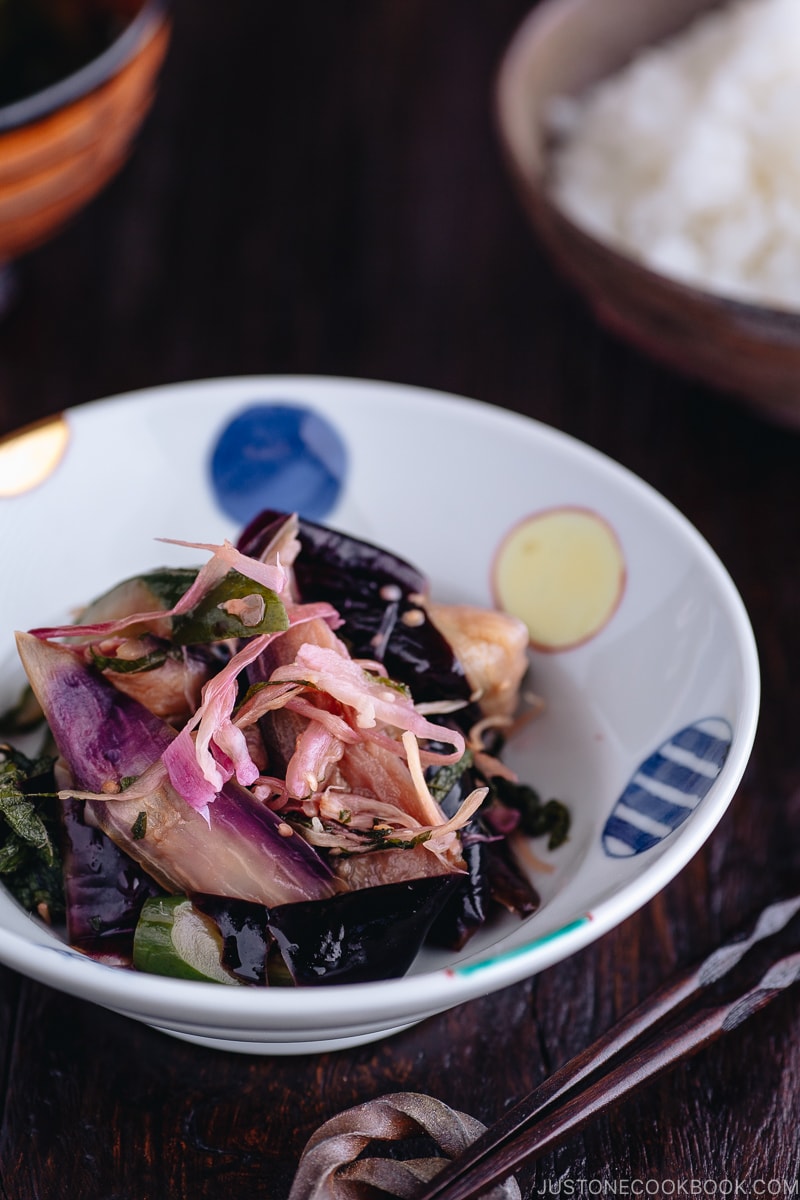
The Shibazuke Recipe
I’ve followed this Japanese recipe to make “quick” shibazuke. Instead of waiting for 3-7 day fermentation, this method can be done in a day or overnight. However, as another site that followed the same recipe also mentioned, the result was a bit too salty.
So I’d like to suggest: 1) reduce the salt from 2% to 1%, and/or 2) don’t leave with salt for half a day. I think 1 hour of pickling might be enough.
I’ve researched online to see if there is a better ratio or perfect timing for pickling, but other recipes are pretty much the same. So I’ll leave it up to you. When I try making it next time, I’ll definitely reduce the salt pickling time and test to see if 1-2 hours would work better.
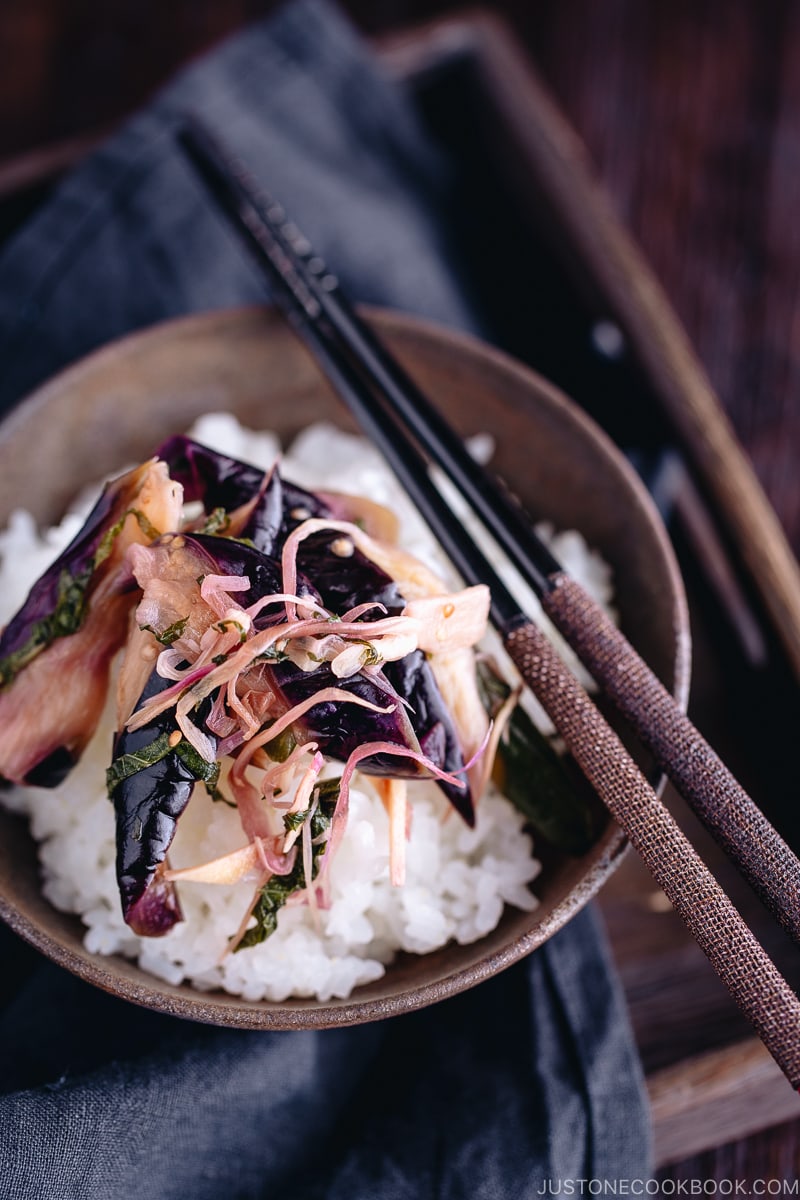
How To Enjoy Shibazuke
The best way to enjoy this pickle is to eat it with delicious steamed rice. I also enjoy eating this pickle with Ochazuke – steamed rice with tea poured over the rice. Shibazuke has a more intense savory flavor than other Japanese pickles. To me, the saltiness and sourness from the pickle add indescribable joy to a humble dish.
Even though my first batch turned out to be a little salty, I still enjoyed this refreshing pickle so much. There are no preservatives or additives. If you are lucky enough to find these unique Japanese ingredients, I hope you get to enjoy making the pickle with fresh summer ingredients.
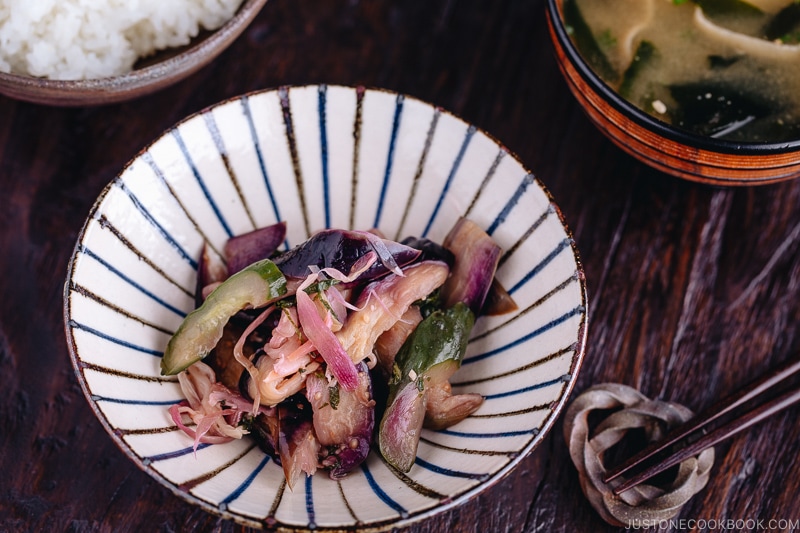
Wish to learn more about Japanese cooking? Sign up for our free newsletter to receive cooking tips & recipe updates! And stay in touch with me on Facebook, Pinterest, YouTube, and Instagram.
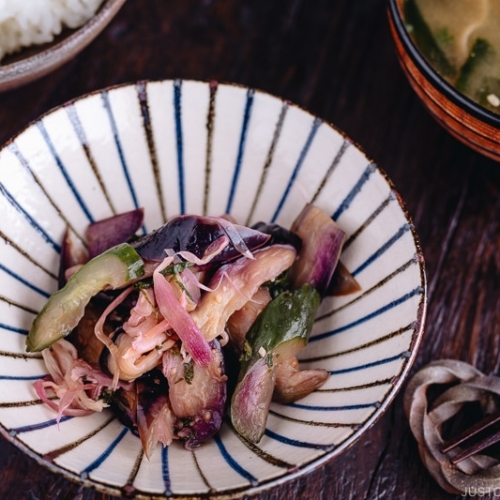
Shibazuke Pickles
Ingredients
- 3 Japanese or Chinese eggplant (14.1 oz, 400 g)
- 2 Japanese or Persian cucumbers (6 oz, 170 g)
- 3 myoga ginger (1.8 oz, 54 g; you can substitute it with a small amount of ginger, preferably mild-flavored young ginger)
- 1 inch ginger (0.8 oz, 22 g)
- Diamond Crystal kosher salt (0.4 oz, 11 g; 2% of total weight of vegetables)
For Pickling
- 20 shiso leaves (perilla/ooba)
- 4 Tbsp ume plum vinegar
- 1 Tbsp mirin
Instructions
- Gather all the ingredients. Wash the vegetables and weigh them. My vegetables weigh 573 g. Use salt equivalent to 2% of the vegetables’ total weight, which is 11 g for me.

- Cut 3 Japanese or Chinese eggplant in half lengthwise and slice diagonally.

- Soak the eggplants in water to prevent them from changing color.

- Cut the ends of 2 Japanese or Persian cucumbers and cut again in half lengthwise.

- Remove the seeds with a small spoon and slice diagonally.

- Cut 3 myoga ginger in half lengthwise and julienne.

- Peel the skin and julienne 1 inch ginger.

- Combine all the vegetables in a freezer bag and sprinkle with the measured Diamond Crystal kosher salt.

- Mix all together and knead the vegetables. Press the vegetables with twice the weight of the vegetables (roughly 1 kg). Leave at room temperature for 1 hour.

- Tightly squeeze the liquid out from the vegetables (you can first drain the vegetables into the strainer, too, if you‘d like) and discard the liquid. Transfer the squeezed vegetables back to the bag.

- Cut 20 shiso leaves (perilla/ooba) into julienne slices.

- Add the shiso leaves, 4 Tbsp ume plum vinegar, and 1 Tbsp mirin in the bag.

- Mix and knead the vegetables.

- Remove the air out of the bag and press with a heavy object. Keep in the refrigerator for 2–3 days and you can start eating it. Transfer to an airtight container or mason jar and consume within 2 weeks.

To Store
- Keep it refrigerated for 2 weeks.
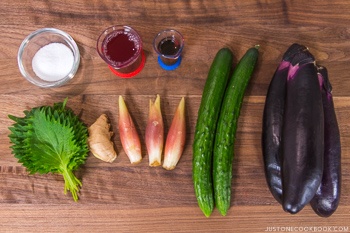
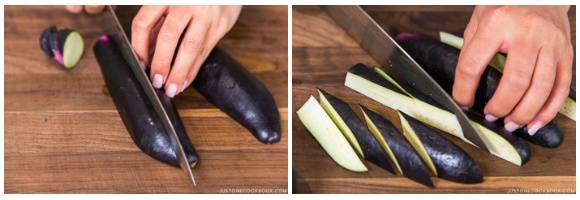
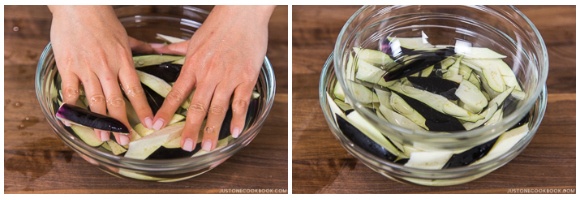
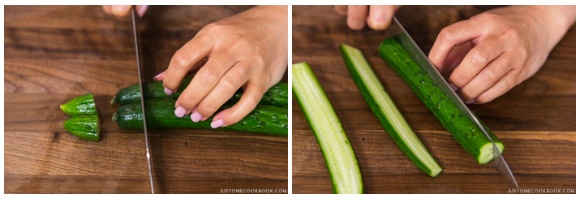
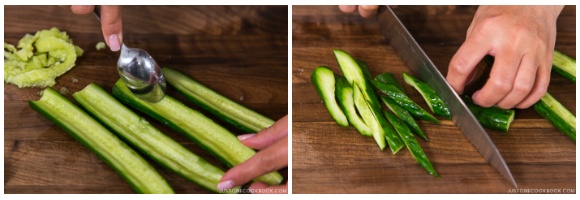
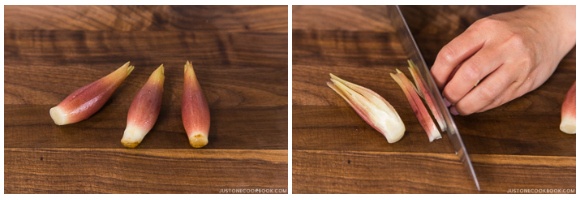
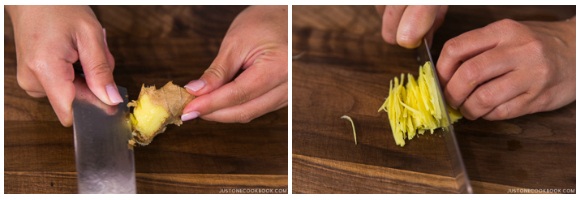
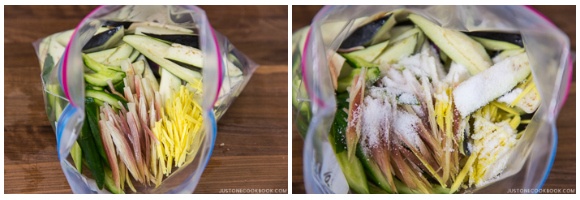
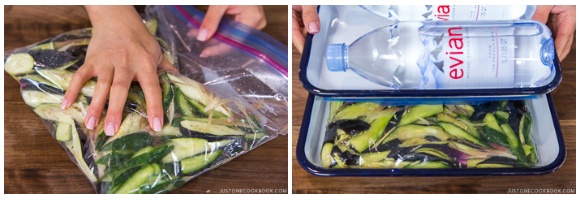
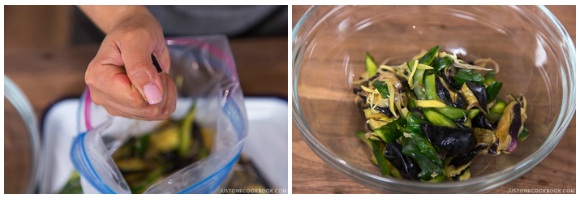
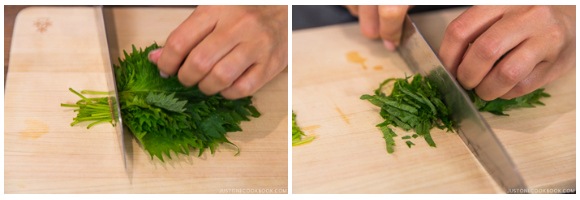
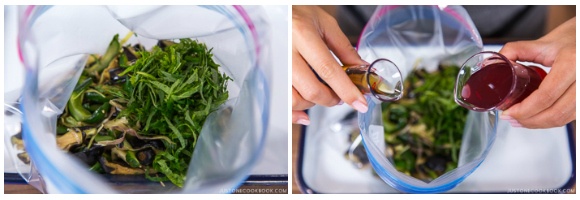
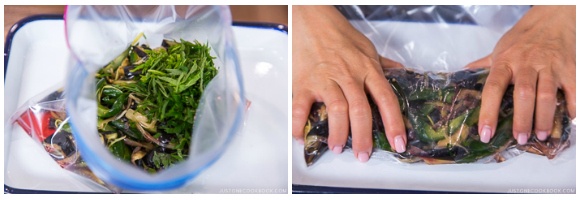
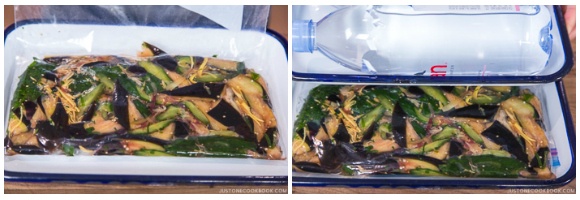











Perhaps getting dried shiso leaves and making a shiso tea/juice would be a decent substitute for the shiso flavor? I saw a video of some japanese folks doing half plum vinegar with some aka shiso leaves in it, half shiso juice, then sugar. They only had to let it sit for a couple hours before the shibazuke was ready 🙂
Hi SJ Therese, Thank you for trying Nami’s recipe!
The dried shiso may work as described for color as ume plum vinegar, but it may not work well for flavor.
We hope this was helpful!
Hi Namiko!
If I wanted the pickle to go through the traditional fermentation step what would I do? Would I just leave it un-refrigerated?
Would this prolong the refrigerated shelf life?
Hi Gavin, Thank you very much for reading Nami’s post and trying her recipe!
To make traditional fermentation pickles, you will need to increase the amount of salt to 6% of total vegetables and extend the pickling time to two weeks at room temperature. The Shibazuke will last about three months in the refrigerator.
We hope this helps!
Hi Namiko, I am trying out this recipe. Why do you squeeze the aka shiso with salt? And do you discard the water that comes out? Or do you keep it and mix it with the mirin and rice vinegar?
Hi Glen, Thank you very much for trying Namiko’s recipe!
Red (aka) shiso contains astringency (‘Aku ‘in Japanese), so we must knead and massage the leaves with salt first before use. And discard the water.
Nami has an Umeboshi recipe, and You can learn more about how to make Ume Plum Vinegar (赤梅酢) in the post: https://www.justonecookbook.com/how-to-make-umeboshi/
We hope this helps!
Hi Namiko and Naomi! I tried this recipe as is and found it kind of bland when compared to store bought/Osaka bought shibazuke. So I offer the following if you will indulge me. If not, just delete. First, it starts out as shiozuke, so I remembered my grandmother and mother making it. I didn’t bother with weights. I just remembered “salt and press until the water comes out.” So I sprinkled salt until it looked about right, then put it in my tsukemono press. I waited about 1.5 hours until I saw water coming out. I pulled out the vegetables, did the squeeze thing, and tasted. It wasn’t very salty so I put a little more salt, maybe two tbls more during the next phase with the aka shiso, mirin, and rice vinegar. I also increased the aka shiso to 60 leaves (I had plenty) and added more vinegar and mirin. Then, I put it back into the press and did what my grandmother used to do, left it out on the counter. I think this is called lactic fermentation. I left it out for about 5 days. It turned out more like the store bought kind. Just food for thought.
Glen
Hi Glen! Thank you very much for trying Nami’s recipe and sharing your cooking experience and tips with us!
Yes. It has different ways and ingredients to make Shibazuke in Japan, other regions/family make in different ways, and your/grandmother’s recipe is also a common way to make it.🙂 So thank you for sharing it!💞
Hi Jorge!
Thank you very much for your support and love!
We are happy to hear you enjoy Nami’s recipes!😊
Maybe the reason the pickle may seem too salty is that you weighed the vegetables and them trimmed them. If you trim first and then weigh, I guess that 2% salt would not seem too much. Just a thought.
Hi Mike! Yeah, that, and also I let it sit too long, I think. As I mentioned in the blog post (and recipe), I believe we can cut down on time. 🙂
As you say, it is nearly impossible to find purple shiso leaves in the United States. That being said, we grow shiso at home. You can buy the seeds of both green and purple varieties online. These annuals are extremely hardy and anyone can grow them regardless of skill. They grow like a weed. Seriously shiso will quickly get out of control and take over your garden within a few years. We reccomend growing in containers because of this.
Sow seeds in a pot during the spring. You will have plenty of fresh shiso leaves that summer. Let the shiso flower and produce seed. You can let the plants self sow (what we do) or harvest and store the seeds for next spring.
Hi Jon! Thank you for sharing your tip with us on growing shiso at home!
Really good even without the Shiso leaves and miyoga. Can’t find that here in Mexico 🙁 I did everything else exact and even cut the salting time to one hour. Still too salty. Maybe they need to be rinsed after the salting step. That might help.
Hi Cheryl! Thank you so much for trying this recipe! You did the 2% salt for vegetables you used right? Hmmm it’s shiozuke and pickles, so it is salty food… I’m sorry it turned out too salty for you.